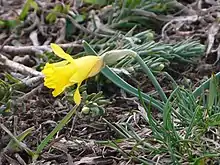Narcissus asturiensis
Narcissus asturiensis, the pygmy daffodil,[3] is a perennial bulbous plant native to the mountains of North Portugal and Spain, where it grows at altitudes up to 2000 m (6000 ft). As of March 2022, Kew sources consider the correct name to be Narcissus cuneiflorus.[1][4]
| Narcissus asturiensis | |
|---|---|
 | |
| Scientific classification | |
| Kingdom: | Plantae |
| Clade: | Tracheophytes |
| Clade: | Angiosperms |
| Clade: | Monocots |
| Order: | Asparagales |
| Family: | Amaryllidaceae |
| Subfamily: | Amaryllidoideae |
| Genus: | Narcissus |
| Species: | N. asturiensis |
| Binomial name | |
| Narcissus asturiensis (Jord.) Pugsley[1] | |
| Synonyms[2] | |
| |
This dwarf Narcissus is 7–12 cm (2.5– 5 in) tall and has small yellow flowers growing singly.
This is a threatened species in the wild, but it is amenable to cultivation.[5] It can be grown as a cold hardy garden plant, needing vernalization (a period of cold weather) in order to flower. As a garden plant, it will bloom in late January or early February at low altitudes.
This plant contains a number of alkaloids including hemanthamine, hemanthidine, tazettine and epimacronine.[6]
Further images
References
- "Narcissus asturiensis (Jord.) Pugsley". Plants of the World Online. Royal Botanic Gardens, Kew. Retrieved 2022-03-15.
- "Narcissus cuneiflorus (Salisb. ex Haw.) Link". Plants of the World Online. Royal Botanic Gardens, Kew. Retrieved 2022-03-15.
- "Narcissus asturiensis (13) | pygmy daffodil Bulbs/RHS Gardening". www.rhs.org.uk. Retrieved 2022-03-15.
- "Narcissus asturiensis". World Checklist of Selected Plant Families (WCSP). Royal Botanic Gardens, Kew. Retrieved 2022-03-15.
- Santos, A.; Fidalgo F.; Santos I.; Salema R. (2002). "In vitro bulb formation of Narcissus asturiensis, a threatened species of the Amaryllidaceae". Journal of Horticultural Science & Biotechnology. 77 (2): 149–152. doi:10.1080/14620316.2002.11511471. S2CID 87286906.
- Lewis, John R. (2000). "Amaryllidaceae, muscarine, imidazole, oxazole, thiazole and peptide alkaloids, and other miscellaneous alkaloids" (PDF). Nat. Prod. Rep. 17 (1): 57–84. doi:10.1039/a809403i. PMID 10714899.


